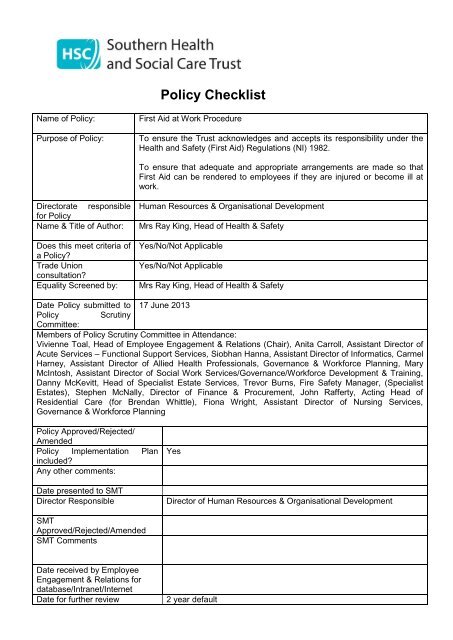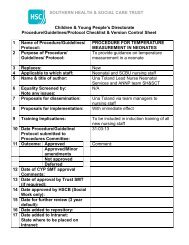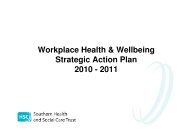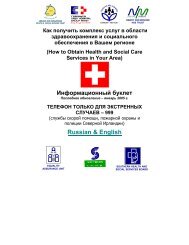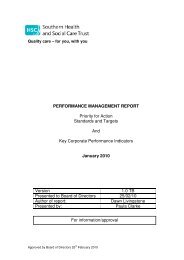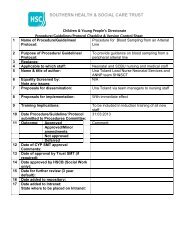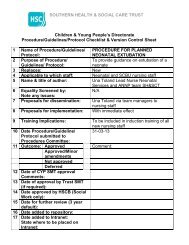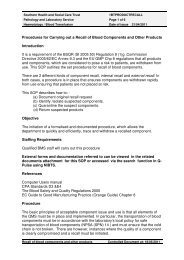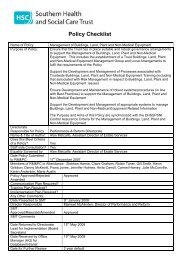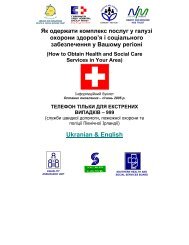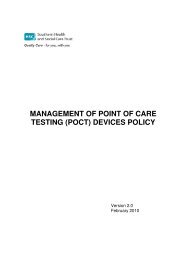First Aid at Work Procedure - Southern Health and Social Care Trust
First Aid at Work Procedure - Southern Health and Social Care Trust
First Aid at Work Procedure - Southern Health and Social Care Trust
Create successful ePaper yourself
Turn your PDF publications into a flip-book with our unique Google optimized e-Paper software.
Policy ChecklistName of Policy:Purpose of Policy:<strong>First</strong> <strong>Aid</strong> <strong>at</strong> <strong>Work</strong> <strong>Procedure</strong>To ensure the <strong>Trust</strong> acknowledges <strong>and</strong> accepts its responsibility under the<strong>Health</strong> <strong>and</strong> Safety (<strong>First</strong> <strong>Aid</strong>) Regul<strong>at</strong>ions (NI) 1982.To ensure th<strong>at</strong> adequ<strong>at</strong>e <strong>and</strong> appropri<strong>at</strong>e arrangements are made so th<strong>at</strong><strong>First</strong> <strong>Aid</strong> can be rendered to employees if they are injured or become ill <strong>at</strong>work.Director<strong>at</strong>e responsiblefor PolicyName & Title of Author:Does this meet criteria ofa Policy?Trade Unionconsult<strong>at</strong>ion?Equality Screened by:Human Resources & Organis<strong>at</strong>ional DevelopmentMrs Ray King, Head of <strong>Health</strong> & SafetyYes/No/Not ApplicableYes/No/Not ApplicableMrs Ray King, Head of <strong>Health</strong> & SafetyD<strong>at</strong>e Policy submitted to 17 June 2013Policy ScrutinyCommittee:Members of Policy Scrutiny Committee in Attendance:Vivienne Toal, Head of Employee Engagement & Rel<strong>at</strong>ions (Chair), Anita Carroll, Assistant Director ofAcute Services – Functional Support Services, Siobhan Hanna, Assistant Director of Inform<strong>at</strong>ics, CarmelHarney, Assistant Director of Allied <strong>Health</strong> Professionals, Governance & <strong>Work</strong>force Planning, MaryMcIntosh, Assistant Director of <strong>Social</strong> <strong>Work</strong> Services/Governance/<strong>Work</strong>force Development & Training,Danny McKevitt, Head of Specialist Est<strong>at</strong>e Services, Trevor Burns, Fire Safety Manager, (SpecialistEst<strong>at</strong>es), Stephen McNally, Director of Finance & Procurement, John Rafferty, Acting Head ofResidential <strong>Care</strong> (for Brendan Whittle), Fiona Wright, Assistant Director of Nursing Services,Governance & <strong>Work</strong>force PlanningPolicy Approved/Rejected/AmendedPolicy Implement<strong>at</strong>ion Planincluded?Any other comments:D<strong>at</strong>e presented to SMTDirector ResponsibleYesDirector of Human Resources & Organis<strong>at</strong>ional DevelopmentSMTApproved/Rejected/AmendedSMT CommentsD<strong>at</strong>e received by EmployeeEngagement & Rel<strong>at</strong>ions ford<strong>at</strong>abase/Intranet/InternetD<strong>at</strong>e for further review2 year default
POLICY DOCUMENT – VERSION CONTROL SHEETTitleTitle: <strong>First</strong> <strong>Aid</strong> <strong>at</strong> <strong>Work</strong> <strong>Procedure</strong>Version: 2.0Reference number/document name:Supersedes Supersedes: <strong>First</strong> <strong>Aid</strong> <strong>at</strong> <strong>Work</strong> <strong>Procedure</strong> March 2010Description of Amendments(s)/Previous Policy or Version:Origin<strong>at</strong>orScrutiny Committee& SMT approvalCircul<strong>at</strong>ionReviewPolicy had exceeded its 2 year default.Additional inform<strong>at</strong>ion has been added in rel<strong>at</strong>ion to <strong>First</strong> <strong>Aid</strong>ers who willbe required to <strong>at</strong>tend a one day emergency first aid <strong>at</strong> work course.Name of Author: Mrs Ray KingTitle: Head of <strong>Health</strong> & SafetyReferred for approval by:D<strong>at</strong>e of Referral:Scrutiny Policy Committee Approval (D<strong>at</strong>e)SMT approval (D<strong>at</strong>e)Issue D<strong>at</strong>e:Circul<strong>at</strong>ed By: <strong>Health</strong> & Safety DepartmentIssued To: As per circul<strong>at</strong>ion List (details below)Review D<strong>at</strong>e:Responsibility of (Name):Title:Circul<strong>at</strong>ion List:This policy was circul<strong>at</strong>ed to the following groups of staff for consult<strong>at</strong>ion:Trade Union SideMembers of the <strong>Health</strong> & Safety CommitteeFollowing approval, this Document will be circul<strong>at</strong>ed to the following:Directors for dissemin<strong>at</strong>ion to their staff<strong>Trust</strong> Intranet site
<strong>First</strong> <strong>Aid</strong> <strong>at</strong> <strong>Work</strong><strong>Procedure</strong><strong>Health</strong> & Safety DepartmentMay 2013
CONTENTS1.0 Introduction Page 12.0 Scope of Procedural Arrangements Page 13.0 Definitions Page 14.0 Responsibilities Page 15.0 Assessment of <strong>First</strong> <strong>Aid</strong> Provision Page 36.0 <strong>First</strong> <strong>Aid</strong> M<strong>at</strong>erials <strong>and</strong> Containers Page 47.0 Inform<strong>at</strong>ion for Employees on <strong>First</strong> <strong>Aid</strong> Arrangements Page 48.0 Training & Competence Page 59.0 Support <strong>and</strong> Further Advice Page 510.0 Equality <strong>and</strong> Human Rights Page 511.0 Review of the <strong>Procedure</strong> Page 512.0 Altern<strong>at</strong>ive Form<strong>at</strong>s Page 513.0 Copyright Page 5Appendix 1.0 – Three Day <strong>First</strong> aid <strong>at</strong> <strong>Work</strong> Course (FAW) Page 6Appendix 2.0 - One Day Emergency <strong>First</strong> <strong>Aid</strong> Course (EFAW) Page 7Appendix 3.0 – Checklist for Assessment of <strong>First</strong> <strong>Aid</strong> Needs Page 8Appendix 4.0 - Suggested numbers of first aid personnel Page 10Appendix 5.0 – <strong>First</strong> <strong>Aid</strong> Containers suggested contents Page 11Appendix 6.0 – <strong>First</strong> <strong>Aid</strong> Notice Page 12
1.0 INTRODUCTIONThe <strong>Southern</strong> <strong>Health</strong> <strong>and</strong> <strong>Social</strong> <strong>Care</strong> <strong>Trust</strong> (<strong>Trust</strong>) acknowledges <strong>and</strong> accepts itsresponsibility under the <strong>Health</strong> <strong>and</strong> Safety (<strong>First</strong> <strong>Aid</strong>) Regul<strong>at</strong>ions (NI) 1982 to ensure th<strong>at</strong>adequ<strong>at</strong>e <strong>and</strong> appropri<strong>at</strong>e arrangements are made so th<strong>at</strong> <strong>First</strong> <strong>Aid</strong> can be rendered toemployees if they are injured or become ill <strong>at</strong> work.The <strong>Trust</strong> also acknowledges th<strong>at</strong> due to the n<strong>at</strong>ure of its undertaking there is a duty toinclude in such arrangements the assessment/tre<strong>at</strong>ment of non-employees such asservice users should they be injured or taken ill whilst on <strong>Trust</strong> premises.2.0 SCOPE OF PROCEDURAL ARRANGEMENTSThese procedural arrangements apply to all staff working within or on behalf of the <strong>Trust</strong>when dealing with situ<strong>at</strong>ions where they may need immedi<strong>at</strong>e <strong>at</strong>tention.3.0 DEFINITIONS3.1 <strong>First</strong> <strong>Aid</strong> <strong>at</strong> <strong>Work</strong>Employers have a legal duty to make arrangements to ensure their employeesreceive immedi<strong>at</strong>e <strong>at</strong>tention if they are injured or become ill <strong>at</strong> work. It is importantto give them immedi<strong>at</strong>e <strong>at</strong>tention <strong>and</strong> call an ambulance in serious cases whetherthe injury or illness is caused by the work they do or not. <strong>First</strong> aid <strong>at</strong> work coversthe arrangements th<strong>at</strong> need to be made to manage injuries or illnesses suffered <strong>at</strong>work.3.2 <strong>First</strong> <strong>Aid</strong>er <strong>at</strong> <strong>Work</strong> (FAW)An individual who has <strong>at</strong>tended a three day HSENI approved training course<strong>and</strong> holds a valid certific<strong>at</strong>e of competence in <strong>First</strong> <strong>Aid</strong> <strong>at</strong> work (refer to Appendix1.0).3.3 Emergency <strong>First</strong> <strong>Aid</strong>er <strong>at</strong> <strong>Work</strong> (EFAW)An individual who has <strong>at</strong>tended an approved one day Emergency <strong>First</strong> <strong>Aid</strong> <strong>at</strong><strong>Work</strong> course, <strong>and</strong> hold a valid certific<strong>at</strong>e of competence. EFAW training enablesthe <strong>First</strong> <strong>Aid</strong>er to give emergency <strong>First</strong> <strong>Aid</strong> to someone who is injured orbecomes ill (refer to Appendix 2.0).4.0 RESPONSIBILITIES4.1 Director of Human Resources <strong>and</strong> Organis<strong>at</strong>ional DevelopmentThe Chief Executive has appointed the Director of Human Resources <strong>and</strong>Organis<strong>at</strong>ional Development as the identified Lead person for <strong>Health</strong> <strong>and</strong> Safetywithin the <strong>Trust</strong>. This includes responsibility for ensuring th<strong>at</strong> the requirements forPage 1 of 12
health <strong>and</strong> safety legisl<strong>at</strong>ion are applied <strong>and</strong> th<strong>at</strong> the <strong>First</strong> <strong>Aid</strong> <strong>at</strong> <strong>Work</strong> ProceduralArrangements are observed <strong>and</strong> brought to the <strong>at</strong>tention of management.4.2 DirectorsIt is the responsibility of Directors to:Dissemin<strong>at</strong>e these procedures within their area of responsibility; <strong>and</strong>Ensure the implement<strong>at</strong>ion of these procedures within their area of responsibilityby providing support <strong>and</strong> advice to their managers.4.3 ManagersManagers are responsible for ensuring th<strong>at</strong>:There is adequ<strong>at</strong>e <strong>First</strong> <strong>Aid</strong> provision within their areas of responsibility.An assessment of the <strong>First</strong> <strong>Aid</strong> needs within their area of responsibility has beencarried out (refer to Appendix 3.0). This should be retained as evidence ofcompliance with the legisl<strong>at</strong>ion.Liaison with other management colleagues takes place where more than onemanager has responsibility for a particular work area, <strong>and</strong> to ensure th<strong>at</strong> a jointapproach is taken in the determin<strong>at</strong>ion of <strong>First</strong> <strong>Aid</strong> provision.Suitably stocked <strong>and</strong> properly identified <strong>First</strong>-<strong>Aid</strong> containers are provided <strong>and</strong>maintained.<strong>First</strong> <strong>Aid</strong> personnel appointed are given the necessary time off to <strong>at</strong>tend theirinitial training <strong>and</strong> subsequent revalid<strong>at</strong>ion training.All staff are informed of the arrangements th<strong>at</strong> have been made in connectionwith the provision of <strong>First</strong> <strong>Aid</strong>, including the loc<strong>at</strong>ion of <strong>First</strong> <strong>Aid</strong>ers <strong>and</strong> <strong>First</strong> <strong>Aid</strong>boxes (refer to Appendix 5.0)Adverse Incidents are reported <strong>and</strong> managed in accordance with the <strong>Trust</strong>sIncident Policy <strong>and</strong> a record kept of any <strong>First</strong> <strong>Aid</strong> administered.<strong>First</strong> <strong>Aid</strong> needs are reviewed to ensure provision remains appropri<strong>at</strong>e.4.4 Head of <strong>Health</strong> <strong>and</strong> SafetyThe Head of <strong>Health</strong> <strong>and</strong> Safety is responsible for providing advice <strong>and</strong> inform<strong>at</strong>ionrel<strong>at</strong>ing to the <strong>Health</strong> <strong>and</strong> Safety (<strong>First</strong> <strong>Aid</strong>) Regul<strong>at</strong>ions (NI) 1982 including anychanges in the Regul<strong>at</strong>ions or requirements placed on the employer.Page 2 of 12
4.5 <strong>First</strong> <strong>Aid</strong>ers (both FAW <strong>and</strong> EFAW)<strong>First</strong> <strong>Aid</strong>ers will:Ensure th<strong>at</strong> their <strong>First</strong> <strong>Aid</strong> <strong>at</strong> <strong>Work</strong> Certific<strong>at</strong>e or Emergency <strong>First</strong> <strong>Aid</strong> <strong>at</strong> <strong>Work</strong>Certific<strong>at</strong>e are kept current by undertaking approved training <strong>and</strong> refreshercourses prior to the expiring of the certific<strong>at</strong>e (every 3 years).Administer <strong>First</strong> <strong>Aid</strong> as required <strong>and</strong> within their capabilities, <strong>and</strong> wherenecessary call for emergency assistance.Keep a record of <strong>First</strong> <strong>Aid</strong> administered on the IR1 form.Ensure th<strong>at</strong> any items used are replaced in the <strong>First</strong> <strong>Aid</strong> containers as soon aspossible after use.Regularly check <strong>First</strong> <strong>Aid</strong> containers to ensure th<strong>at</strong> they are kept stocked <strong>and</strong>th<strong>at</strong> stocks are in d<strong>at</strong>e.4.6 Employee ResponsibilitiesAll employees must ensure th<strong>at</strong> they are aware of the <strong>First</strong> <strong>Aid</strong> arrangement withintheir immedi<strong>at</strong>e work area <strong>and</strong> in particular should acquaint themselves with thenames <strong>and</strong> loc<strong>at</strong>ion of their relevant <strong>First</strong> <strong>Aid</strong>ers.Following any incident, record the details on the web based reporting system in linewith the <strong>Trust</strong> Incident Reporting Policies & <strong>Procedure</strong>s.5.0 ASSESSMENT OF FIRST AID PROVISION5.1 The approved Code of Practice recommends th<strong>at</strong> an assessment should beundertaken to determine the n<strong>at</strong>ure <strong>and</strong> extent of first aid provision <strong>and</strong> the numberof <strong>First</strong> <strong>Aid</strong>ers required (i.e. FAW <strong>and</strong> EFAW)5.2 In determining the n<strong>at</strong>ure <strong>and</strong> extent of <strong>First</strong> <strong>Aid</strong> provision the following factors needto be taken into account:In assessing <strong>First</strong> <strong>Aid</strong> needs Managers should consider the:(a) N<strong>at</strong>ure of the work <strong>and</strong> workplace hazards <strong>and</strong> risks;(b) Size of the department/ward/service;(c) N<strong>at</strong>ure of the workforce;(d) History of adverse incidents;(e) Needs of travelling, remote <strong>and</strong> lone workers;(f) <strong>Work</strong> p<strong>at</strong>terns;(g) Distribution of the workforce;(h) Remoteness of the site from emergency services;(i) Employees working on shared or multi occupied sites;(j) Annual leave <strong>and</strong> other absences of first aiders <strong>and</strong> appointed persons;Page 3 of 12
(k) <strong>First</strong> <strong>Aid</strong> provision for non-employees;(l) Requirements under the RQIA m<strong>and</strong><strong>at</strong>ory training st<strong>and</strong>ards for Regul<strong>at</strong>ed <strong>Care</strong>Services.5.3 Each Head of Service will be responsible for ensuring th<strong>at</strong> the Managersresponsible <strong>and</strong> accountable to them appoint sufficient certified <strong>First</strong> <strong>Aid</strong>ers FAW orEFAW to meet the needs of their services.5.4 Qualified Medical Doctors registered with the General Medical Council <strong>and</strong> nursesregistered as registered nurses with the Nursing <strong>and</strong> Midwifery Council aredeemed, by their training, to be qualified to administer <strong>First</strong> <strong>Aid</strong>.5.5 The regul<strong>at</strong>ions do not require employers to provide <strong>First</strong> <strong>Aid</strong> to anyone other thantheir employees. However, the n<strong>at</strong>ure of the <strong>Trust</strong> business is such th<strong>at</strong> there isregular involvement with service users <strong>and</strong> members of the public. It is thereforeimportant to give consider<strong>at</strong>ion to these groups in the assessment of need for <strong>First</strong><strong>Aid</strong> provision.5.6 In order to meet RQIA m<strong>and</strong><strong>at</strong>ory training st<strong>and</strong>ards for Regul<strong>at</strong>ed <strong>Care</strong> Services,the <strong>First</strong> <strong>Aid</strong> assessment should include th<strong>at</strong>:All residential care staff <strong>and</strong> day care staff complete EFAW training.Appendix 3.0 provides guidance in how to assess <strong>First</strong> <strong>Aid</strong> needs <strong>and</strong> record relevantinform<strong>at</strong>ion.6.0 FIRST AID MATERIALS AND CONTAINERSWhen the assessment of <strong>First</strong> <strong>Aid</strong> requirements has been completed, the manager shallprovide the m<strong>at</strong>erials <strong>and</strong> equipment needed to ensure th<strong>at</strong> the level of first aid equipmentwill be available to employees <strong>at</strong> all times. This will include ensuring th<strong>at</strong> first aidcontainers, suitably marked, are easily accessible <strong>and</strong> is available in all places whereworking conditions require it. It is preferable th<strong>at</strong> these are placed near the h<strong>and</strong> washingfacilities. A suggested content list is provided in Appendix 5.0.Depending on the finding of the <strong>First</strong> <strong>Aid</strong> needs assessment, more than one <strong>First</strong> <strong>Aid</strong>container might be required.7.0 INFORMATION FOR EMPLOYEES ON FIRST AID ARRANGEMENTSManagers are required to develop procedures for informing staff of the arrangements th<strong>at</strong>have been made in connection with the provision of <strong>First</strong> <strong>Aid</strong> including the loc<strong>at</strong>ion ofequipment <strong>and</strong> the names of <strong>First</strong> <strong>Aid</strong>ers. They should be displayed in a prominentposition (refer to Appendix 6.0).Page 4 of 12
8.0 TRAINING & COMPETENCEAll <strong>First</strong> <strong>Aid</strong>ers (either FAW or EFAW) must hold a valid certific<strong>at</strong>e of competence in <strong>First</strong><strong>Aid</strong> <strong>at</strong> work. Prior to the expiry d<strong>at</strong>e on the certific<strong>at</strong>e a refresher course is required forrenewal of the certific<strong>at</strong>es validity. Details of <strong>First</strong> <strong>Aid</strong> courses are available from theEduc<strong>at</strong>ion, Learning <strong>and</strong> Development Department or via the intranet. Records of trainingare kept centrally by the Educ<strong>at</strong>ion, Learning <strong>and</strong> Development Department. It is theindividual’s responsibility to ensure th<strong>at</strong> their certific<strong>at</strong>e is valid <strong>and</strong> th<strong>at</strong> re-valid<strong>at</strong>iontraining is accounted for in their PDP.9.0 SUPPORT AND FURTHER ADVICEFurther inform<strong>at</strong>ion <strong>and</strong> advice with regard to the <strong>First</strong> <strong>Aid</strong> Regul<strong>at</strong>ions <strong>and</strong> <strong>First</strong> <strong>Aid</strong> RiskAssessment is available from the <strong>Health</strong> & Safety Department.These procedural arrangements should also be read in conjunction with other relevant<strong>Trust</strong> policies <strong>and</strong> procedures, for example,• <strong>Health</strong> & Safety <strong>at</strong> <strong>Work</strong> Policy• Management of Adverse Incidents Policy/<strong>Procedure</strong>• Risk Management Str<strong>at</strong>egy10.0 EQUALITY AND HUMAN RIGHTSThe <strong>Trust</strong>’s equality <strong>and</strong> human rights st<strong>at</strong>utory oblig<strong>at</strong>ions have been considered duringthe development of these Procedural Arrangements.11.0 REVIEW OF THE PROCEDUREThe Head of <strong>Health</strong> <strong>and</strong> Safety will review these Procedural Arrangements within 2 yearsor earlier in the light of any changes in st<strong>at</strong>utory legisl<strong>at</strong>ion <strong>and</strong>/or oper<strong>at</strong>ional experienceth<strong>at</strong> prevents these procedural arrangements being implemented as intended.12.0 ALTERNATIVE FORMATSThis document can be made available on request in altern<strong>at</strong>ive form<strong>at</strong>s, e.g. plain English,Braille, DAISY, audiocassette, disk <strong>and</strong> in other languages to meet the needs of those whoare not fluent in English.13.0 COPYRIGHTThe supply of inform<strong>at</strong>ion under the Freedom of Inform<strong>at</strong>ion does not give the recipient ororganis<strong>at</strong>ion th<strong>at</strong> receives it the autom<strong>at</strong>ic right to re-use it in anyway th<strong>at</strong> would infringecopyright. This includes, for example, making multiple copies, publishing <strong>and</strong> issuingcopies to the public. Permission to re-use the inform<strong>at</strong>ion must be obtained in advancefrom the <strong>Trust</strong>.Page 5 of 12
APPENDIX 1.0Three day <strong>First</strong> <strong>Aid</strong> <strong>at</strong> <strong>Work</strong> Course (FAW)On the completion of this course, the <strong>First</strong> <strong>Aid</strong>er (FAW) is issued with a certific<strong>at</strong>e whichallows them to be valid for three years from the d<strong>at</strong>e of issue.This training allows the <strong>First</strong> <strong>Aid</strong>er to:1.0 (a) Underst<strong>and</strong> the role of the <strong>First</strong> <strong>Aid</strong>er including reference to:i. The importance of preventing cross-infectionii. The need for recording incidents <strong>and</strong> actionsiii. Use of available equipment(b)(c)(d)(e)(f)(g)(h)Assessing the situ<strong>at</strong>ion <strong>and</strong> circumstances in order to act safely, promptly<strong>and</strong> effectively in an emergencyAdministering <strong>First</strong> <strong>Aid</strong> to a casualty who is unconscious (including seizure)Administering cardiopulmonary resuscit<strong>at</strong>ionAdministering <strong>First</strong> <strong>Aid</strong> to a casualty who is wounded <strong>and</strong> bleedingAdministering <strong>First</strong> <strong>Aid</strong> to a casualty who is chokingAdministering <strong>First</strong> <strong>Aid</strong> to a casualty who is suffering from shockProviding appropri<strong>at</strong>e <strong>First</strong> <strong>Aid</strong> for minor injuriesAnd2.0 Administer <strong>First</strong> <strong>Aid</strong> to a casualty with:Injuries to bones, muscles <strong>and</strong> joints including suspected spinal injuriesChest injuriesBurns <strong>and</strong> scaldsEye injuriesAnaphylactic shockSudden poisoningAnd3.0 Recognize the presence of major illness <strong>and</strong> provide appropri<strong>at</strong>e <strong>First</strong> <strong>Aid</strong>Page 6 of 12
APPENDIX 2.0One Day Emergency <strong>First</strong> <strong>Aid</strong> Course (EFAW)On completion of this course, the <strong>First</strong> <strong>Aid</strong>er (WFAW) is issued with a certific<strong>at</strong>e which isvalid for three years from the d<strong>at</strong>e of issue.This training allows the <strong>First</strong> <strong>Aid</strong>er to:(a)(b)(c)(d)(e)(f)(g)(h)Underst<strong>and</strong> the role of the <strong>First</strong> <strong>Aid</strong>er including reference to:i. The importance of preventing cross-infectionii. The need for recording incidents <strong>and</strong> actionsiii. Use of available equipmentAssessing the situ<strong>at</strong>ion <strong>and</strong> circumstances in order to act safely promptly <strong>and</strong>effectively in an emergencyAdministering <strong>First</strong> <strong>Aid</strong> to a casualty who is unconscious (including seizure)Administering cardiopulmonary resuscit<strong>at</strong>ionAdministering <strong>First</strong> <strong>Aid</strong> to a casualty who is wounded <strong>and</strong> bleedingAdministering <strong>First</strong> <strong>Aid</strong> to a casualty who is chokingAdministering <strong>First</strong> <strong>Aid</strong> to a casualty who is suffering from shockProviding appropri<strong>at</strong>e <strong>First</strong> <strong>Aid</strong> for minor injuriesPage 7 of 12
APPENDIX 3.0Checklist for Assessment of <strong>First</strong>-<strong>Aid</strong> NeedsThis checklist can be used to assist you in determining the number of FAW <strong>and</strong> EFAWrequired in your area of responsibility.Factors to Consider1. Does your workplace have low-levelrisks such as those th<strong>at</strong> might be foundin offices?Space for Notes2. Wh<strong>at</strong> are the risks of injury <strong>and</strong> ill-healtharising from the work as identified inyour risk assessments?3. Are there any specific risks, e.g. workingwith:- hazardous substances;- dangerous tools;- dangerous machinery;- dangerous loads or animals- confined spaces4. Are there parts of your establishmentwhere different levels of risk can beidentified?5. How many people are employed on sitein your area of responsibility?6. Are the premises spread out e.g. arethere several buildings on the site ormulti-floor buildings?7. Are there inexperienced workers on site,or employees with disabilities orparticular health problems?8. Is there shift work or out of hoursworking?Page 8 of 12
Factors to consider9. Is your workplace remote fromemergency medical services?Space for Notes10. Do you have employees who travel a lot,work remotely or work alone?11. Do any of your employees work <strong>at</strong> sitesoccupied by other employers? (Sharedor multi-occupied sites)If ‘yes’ liaise with the other Managers<strong>and</strong> ensure joint approach is taken12. Do members of the public visit yourpremises?13. Do you have employees with reading orlanguage difficulties?14. Wh<strong>at</strong> is your record of adverse incidents<strong>and</strong> ill health? Wh<strong>at</strong> type are they <strong>and</strong>where did they happen?15. Do you have sufficient provision to coverabsences of first-aiders or appointedpersons?16. Are you under RQIA Regul<strong>at</strong>ed <strong>Care</strong>ServicesIf ‘yes’, all residential <strong>Care</strong> staff should completeEFAW all Day <strong>Care</strong> Staff should complete EFAWSign<strong>at</strong>ure of Manager ________________________________________Name of Manager ____________________________________________BLOCK CAPITALS PLEASED<strong>at</strong>e _______________________________Once completed, please retain this as evidence of compliance with legisl<strong>at</strong>ion.Page 9 of 12
APPENDIX 4.0Suggested numbers of first-aid personnel to be available <strong>at</strong> all times people are <strong>at</strong>work1. From your riskassessment, wh<strong>at</strong>degree of hazard isassoci<strong>at</strong>ed with yourwork activities?2. How many employeesdo you have?3. How many first aid personneldo you need?Lower Hazard e.g.offices, clinics, ward.Higher Hazard e.g.extensive work withhazardous machineryor sharp instruments.Examples includelaundry, c<strong>at</strong>ering.Residential <strong>and</strong> Day<strong>Care</strong> Setting1 – 50 At least one first-aider trained inEFAW 1More than 50At least one first-aider trained inFAW 2 for every 100 employed (orpart thereof)1-50 At least one first-aider trained inEFAW of FAW depending on thetype of injuries th<strong>at</strong> might occurMore than 50Not applicableAt least one first-aider trained inFAW for every 50 employed (or partthereof)All residential <strong>and</strong> day care stafftrained in EFAW 1 in accordancewith requirements of RQIA4. Wh<strong>at</strong> injuries <strong>and</strong>illnesses havepreviously occurredin your workplace?5. Have you takenaccount of thefactors listed th<strong>at</strong>may affect your firstaid provision?• Ensure any injuries <strong>and</strong> illnesses th<strong>at</strong> might occur can be dealtwith by the first-aid personnel you provide• Where first-aiders are shown to be unnecessary, there is still apossibility of an incident or sudden illness, so you may wish toconsider providing qualified first-aiders• Inexperienced workers or employees with disabilities orparticular health problems• Employees who travel a lot, work remotely or work alone• Employees who work shifts or out of hours• Premises spread out across buildings/floors• <strong>Work</strong>place remote from emergency medical services• Employees working <strong>at</strong> sites occupied by other employers• Planned <strong>and</strong> unplanned absences of first-aiders/appointedpersons• Members of the public who visit the workplace or others on site1 EFAW – Emergency <strong>First</strong> <strong>Aid</strong> <strong>at</strong> <strong>Work</strong>2 FAW – <strong>First</strong> <strong>Aid</strong> <strong>at</strong> <strong>Work</strong>Page 10 of 12
APPENDIX 5.0<strong>First</strong>-<strong>Aid</strong> Containers Suggested ContentsAll <strong>First</strong> <strong>Aid</strong> containers must display a white cross on a green background <strong>and</strong> shouldcontain the following:• A leaflet giving general guidance on <strong>First</strong> <strong>Aid</strong> e.g. HSE leafletBasic advice on <strong>First</strong> <strong>Aid</strong> <strong>at</strong> <strong>Work</strong>.• 20 individually wrapped sterile adhesive dressings (assortedsizes), appropri<strong>at</strong>e to the type of work (dressings may be of adetectable type (blue) for food h<strong>and</strong>lers)• Two sterile eye pads• Four individually wrapped triangular b<strong>and</strong>ages (preferablysterile).• Six safety pins.• Six medium sized (approxim<strong>at</strong>ely 12cmx12cm) individuallywrapped sterile unmedic<strong>at</strong>ed wound dressings.• Two large (approxim<strong>at</strong>ely 18cmx18cm), sterile individuallywrapped unmedic<strong>at</strong>ed wound dressings.• One pair of disposable gloves (non-l<strong>at</strong>ex or powder-free, lowprotein l<strong>at</strong>ex).Medicines, tablets or creams should not be kept in the first-aid container.The contents of the <strong>First</strong>-<strong>Aid</strong> containers should be examined frequently <strong>and</strong> restockedsoon after use. Sufficient supplies should be held in stock on site. <strong>Care</strong> should be takento dispose of items safely once they reach their expiry d<strong>at</strong>e.Page 11 of 12
APPENDIX 6.0 – <strong>First</strong> <strong>Aid</strong> Notice<strong>First</strong> <strong>Aid</strong>Your first aiders are:The nearest first aid box is situ<strong>at</strong>ed:Page 12 of 12


